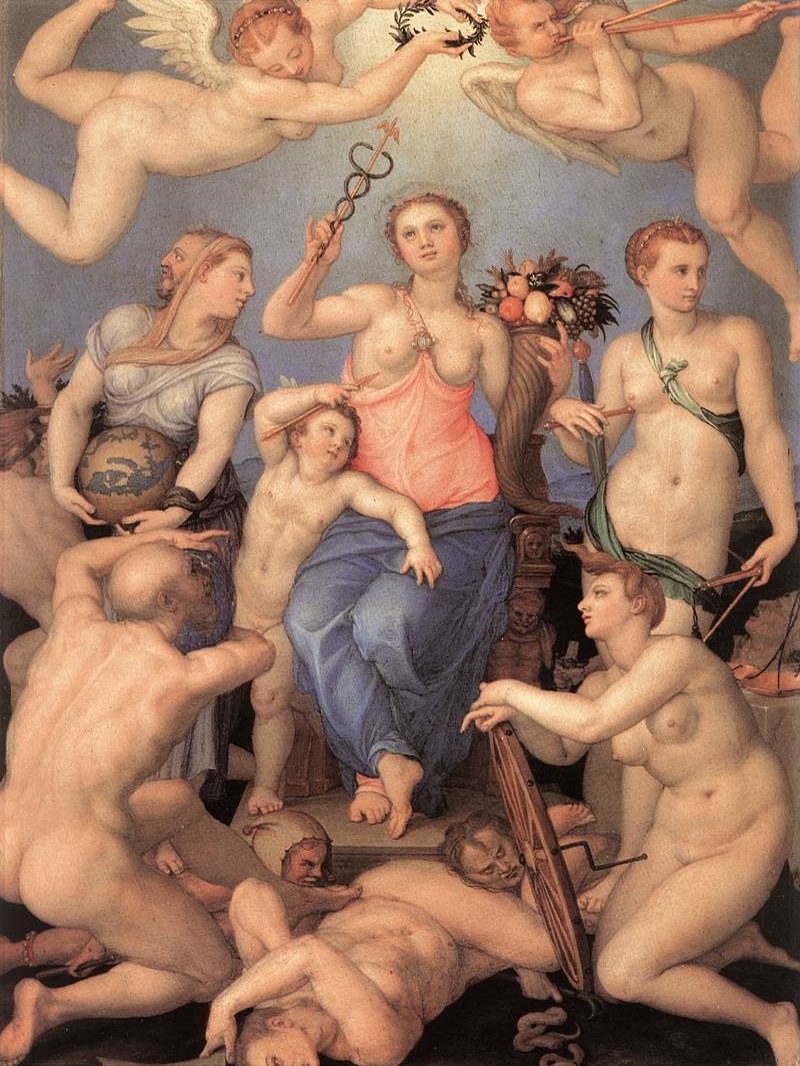It is often said, and rightly so, that many Mannerist works are imbued with symbols that are not always easy to recognize and interpret. Let’s go and see one of them, and in order not to bother the overused “Allegory of the Triumph of Venus” we will choose another one, also by Bronzino, but much less known and which, despite its small size, offers a remarkable density of symbols and metaphors.
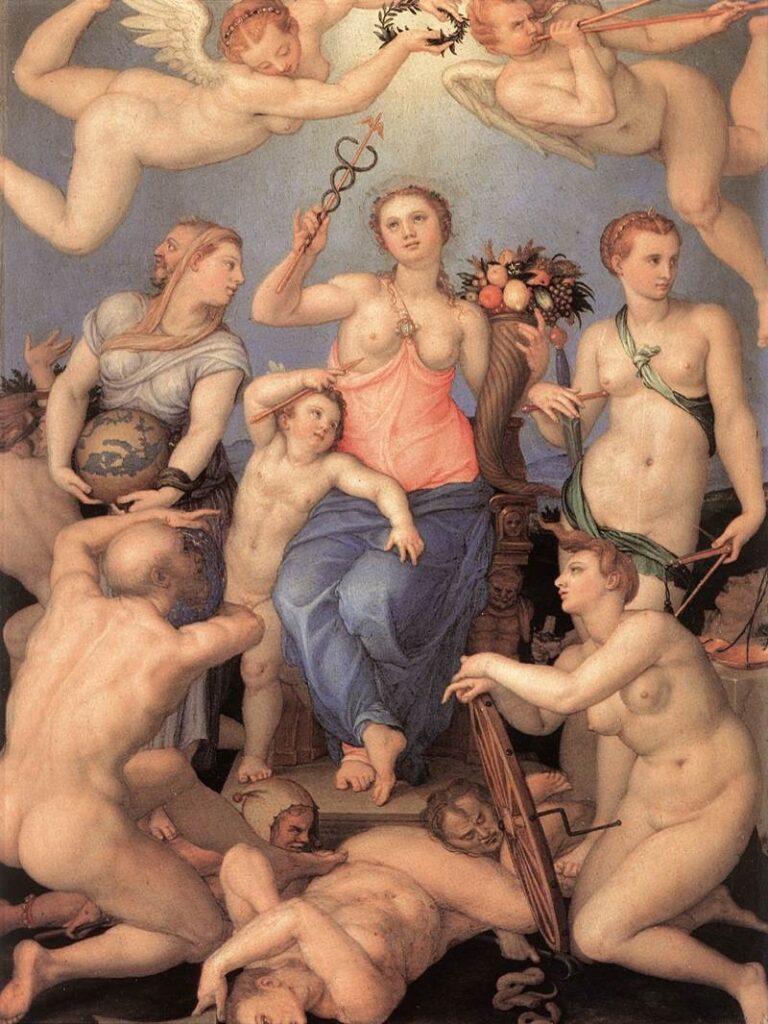
When Francesco I de’ Medici took over the regency of the Grand Duchy of Tuscany from his father Cosimo in 1564, he already had a long history of working with the now elderly Bronzino. The first time they had faced each other was about twenty years earlier when the young Francesco had posed with his mother, Eleanor of Toledo, for one of the many portraits commissioned by the family

It is in the three-year period 1565-7, immediately following his rise to power, that we can date the Allegory of Public Happiness in Florence, an oil on copper measuring just 30×40 cm that Bronzino painted for Grand Duke Francesco and that we can now admire in the Uffizi.
There seems to be no documentary evidence of this commission, but some elements make it almost certain: Francesco’s habit of collecting works on that particular material, the quotation by Vasari in the second edition of his Lives that went into print in 1568 (which also serves us to establish the upper margin of the dating) according to which “al detto signor Prencipe [Francesco I] ha dipinto, sono pochi mesi, un quadretto di piccole figure che non ha pari“1 but above all a commemorative medal coined by Domenico Poggini in 1564, today at the Bargello Museum, with the portrait of Prince Francesco on the obverse and on the reverse the same allegory of the painting, even if limited to the three main figures and the motto of Virgilian origin “Dii nostra incoepta secundent“.
The structure of the work seems to be an explicit reference to Raphael’s Madonna del Baldacchino (which Bronzino could admire in Florence)

but instead of the sacred subject we find at the top Happiness surrounded by Fame and Glory, Prudence and Justice at the sides and Time and Fortune kneeling in front while Foolishness, Fury and Chance lie dejected at their feet.
The iconography of Happiness with caduceus and cornucopia has ancient origins. We find it already in Roman times as can be seen from these denarii of Macrinus and Caracalla


arriving unscathed at Cesare Ripa’s Iconologia in which we also find traces of the personifications of Justice and Prudence as depicted by Bronzino both in this work and, in the mid 1540s, in the chapel of Eleonora, mother of Francesco I, and, even if only in the form of attributes, in Andrea Alciato’s Emblemata
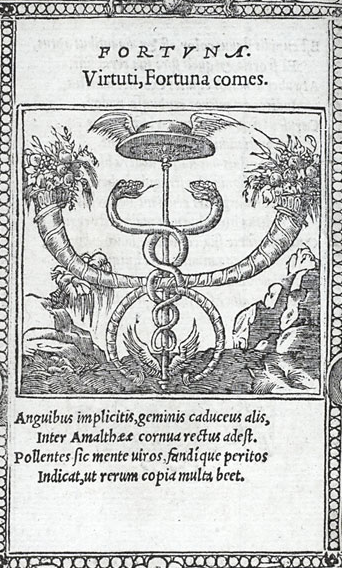
The ancestry to the Roman felicitas, which in turn refers directly to the greek eudaimonia, helps us to understand that we are not talking about individual happiness as we commonly understand it today but of the full and conscious exercise of virtue, exercise that, if implemented by the prince, reverberates on the people in the form of abundance and good government (felicitas publica). His attributes, caduceus and cornucopia, represent in fact respectively virtue and abundance, coherently with what is described in another famous symbolic compendium of the time, “Le imagini de gli dei de gli antichi“2 by Vincenzo Cartari. In the work, in fact, accompanying the image of Happiness, there is a caption that reads “Imagine della Dea Macaria ò Dea Felicità, figliuola, d’Hercole, con il Caduceo, & il corno di Dovitia in mano quello significante la virtù, questo le ricchezze, necessarie e l’una, è l’altre alla felicità humana“3.
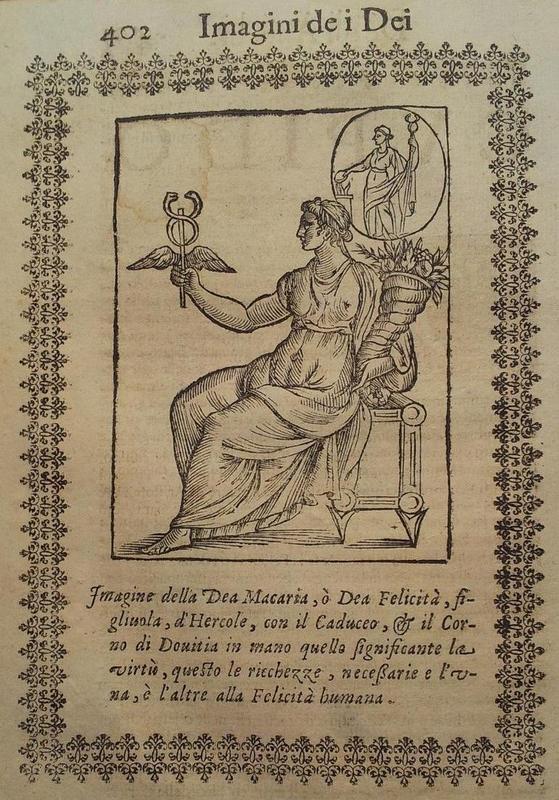
As Sara Agnoletto wrote “These images crystallize the trust of humanists in the good Fortune that, operating in agreement with Virtue, facilitates men in the achievement of their enterprises: Fortune and Mercury, success and personal merit are one. But Fortune is not a force on which one can rely, because it is changeable and from one moment to another, unexpectedly, it can change. Instead, it is important to cultivate the ‘arts’, which allow one to cope with adverse fate and, unlike the latter, ensure a sure outcome.”
Ditto Alciati: “As Fortune on the sphere, so Hermes sits on a cube: this governs the arts, and that the different events of fate. Art is made against the force of fortune: but when fate is adverse, it often requires the means of art. O studious youth, learn the good arts, which certainly go with the advantages of good fortune.”
Coming to the outline figures, Prudence, two-faced, turns the female face to her (in all probability that of Joan of Austria, married by Francis I in 1564, as we know her from Alessandro Allori’s portrait of 1568) and with one foot crushes madness while the male face (resembling that of Cosimo I) puts a figure identifiable with Envy/Jealousy to flight.
The presence of Eros, as well as the uncovered breast of Felicity, are unprecedented in the established iconography and are both referable to the model of Venus Felix and Fecunditas alluding to the marriage of the Prince and to the hoped-for birth of an heir who would have given stability and continuity to the family, contributing to public happiness. The two models in fact, although endowed with different meanings, are both iconographically assimilated to Fortuna as can be seen in these sesterces of Giulia Mamea
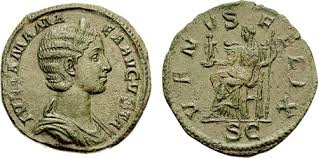
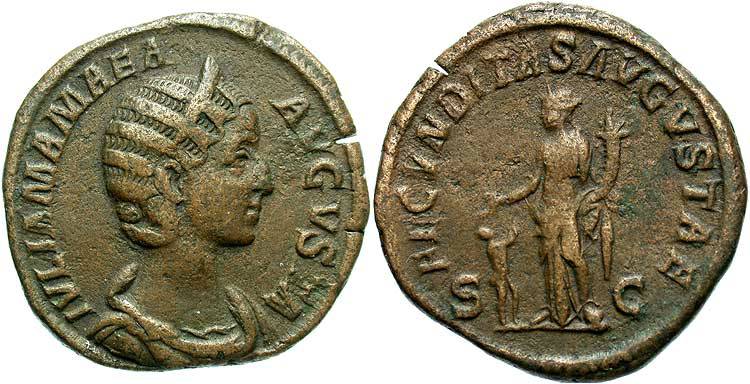
This mixture of the civic and the erotic and the sense that it assumes in the painting do not sound so strange in light of a letter sent by Vincenzo Borghini, an intellectual who was a member of the Medici court in those years, to Cosimo I not long before. Borghini, speaking of the public festivities held or to be held in Florence (probably for the marriage of Francesco), describes the spirit that animates them as follows: “A demonstration and expression of public joy and contentment, accompanied by honouring and celebrating their princesses on the part of the bridegroom as well as the bride […] a declaration of the public hope of the comforts, honours, glory and happiness that will result from those celebrations”.
Justice, portrayed naked as Truth, holds Fury at bay with the scales while crushing Deception, whose defeat is also symbolized by the decapitated serpent.
Time is strangely devoid of wings and hourglass (which he possesses in the Allegory of the Triumph of Venus painted by Bronzino a few years earlier) but he is consistently elderly and clutches a celestial sphere, the symbol of eternity.
The last two figures, the one kneeling on the right and the one lying on the ground at the bottom, should be considered separately. It could in fact be a sort of doubling, that is, two aspects of the same idea-personage represented by different personifications. The concept is the Greek one of kairos, which the Latins translated as occasio, the opportunity to be seized (because of the long forelock of the kneeling figure) when it is in front of you, while it becomes impossible to catch it after it has passed (bald nape). Another attribute of Kairos was a blade, like the one held in the hand of the figure on the ground, “because it must be at once to cut off every sort of impediment” as its caption in the already mentioned Iconology states. We would therefore find ourselves in front of a Time that, defeating the fleetingness of Kairos, indefinitely prolongs the propitious moment offered by Occasio-Fortuna, duly tamed. An element in favor of this interpretation, and that can be seen by consulting the sources, is that this idea of continuity without jolts was particularly suitable for the moment in which the work was commissioned, that is, the years immediately following the assumption of the regency of the Grand Duchy by Francesco.
In spite of this intricate net of symbologies and auspices, Francis, although not without some merit, will not succeed in being exactly that model to which, at least in public, he aspired. He died some twenty years later, in 1587, after returning from a hunting trip. The old Bronzino, the algid projectionist of the (presumed) Medici virtues on the tarpaulin of eternity, had already been in the ground for some time (1572).
A side note: in order to perceive the enormous fortune and diffusion of the iconographic summae of the time (Ripa, Alciato, Cartari) to which we have referred to in the discussion, and to which we will come back, it is enough to think that sixty years later the French court commissioned to Orazio Gentileschi another “Allegory of happiness”, also based on those models (in this case mainly Ripa)
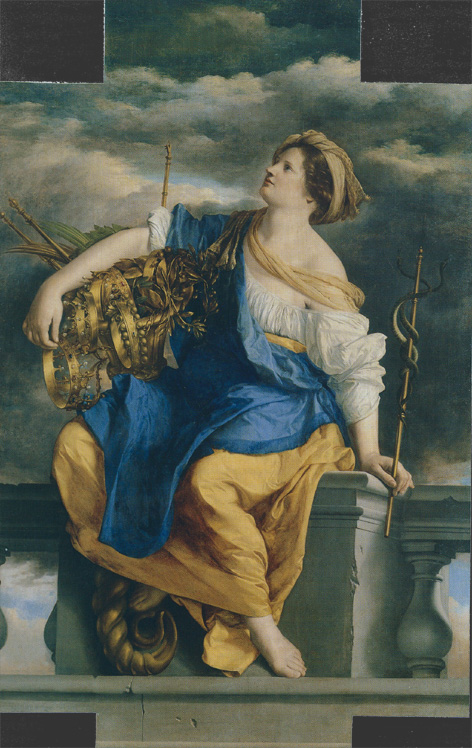
and curiously the subject symbolized as the icon of good government is Maria de’ Medici, daughter of the aforementioned Francis I as well as queen of France since she was the wife of the deceased Henry IV and regent in the name of her son Louis XIII. del figlio Luigi XIII.
- few moths ago he painted for the Prince [Francesco I] a picture of small figures that has no equal
- Ancients’ gods images
- Image of the Goddess Macaria or Goddess Happiness, daughter of Hercules, with the Caduceus, & the horn of abundance in her hand, the one signifying virtue, the other riches, necessary and one, is the other to human happiness
